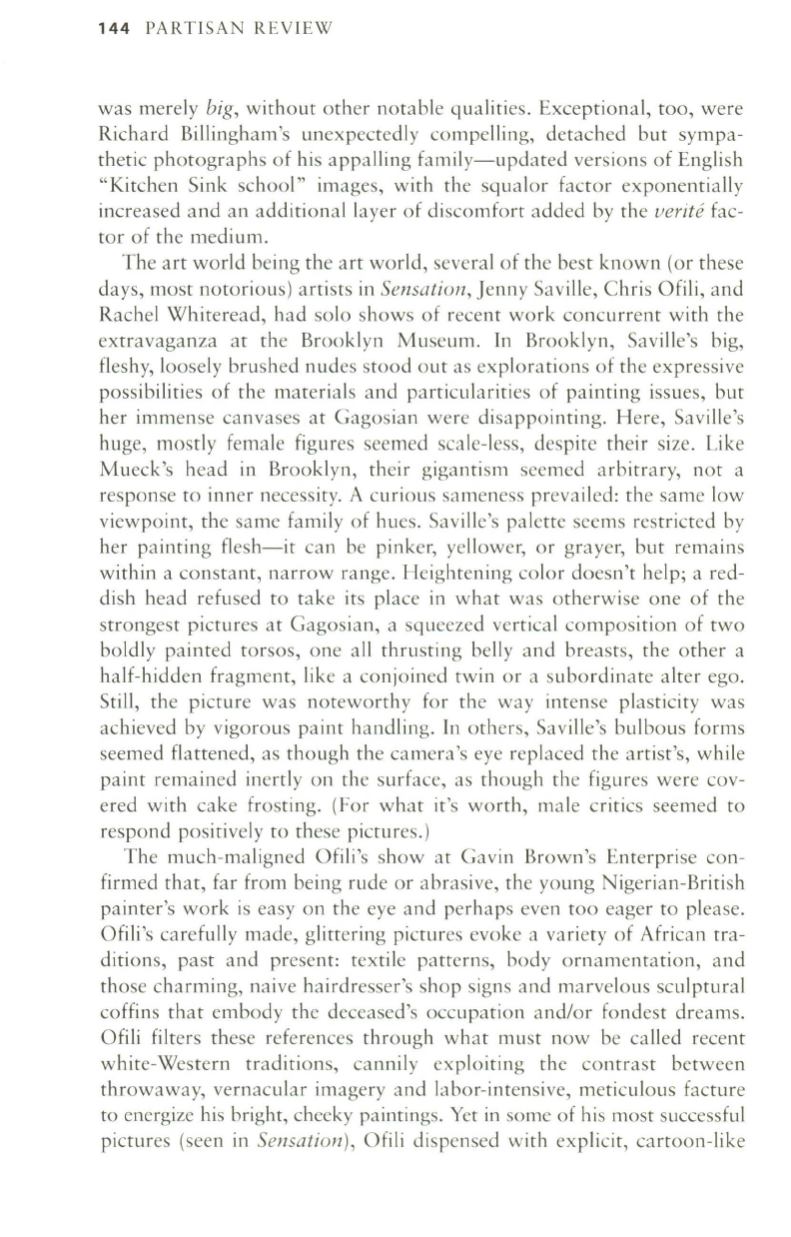
144
PARTISAN REVIEW
was merely
big,
without other notable qualities. Exceptional, too, were
Richard Billingham's unexpectedly compelling, detached but sympa–
thetic photographs of his appalling family-updated versions of English
"Kitchen Sink school" images, with the squalor factor exponentially
increased and an additional layer of discomfort added by the
verite
fac–
tor of the medium.
The art world being the art world, several of the best known (or these
days, most notorious) artists in
Sensation,
Jenny Saville, Chris Ofiii, and
Rachel Whiteread, had solo shows of recent work concurrent with the
extravaganza at the Brooklyn Museum. In Brooklyn, Saville's big,
fleshy, loosely brushed nudes stood out as explorations of the expressive
possibilities of the materials and particularities of painting issues, but
her immense canvases at Gagosian were disappointing. Here, Saville's
huge, mostly female figures seemed scale-less, despite their size. Like
Mueck's head in Brooklyn, their gigantism seemed arbitrary, not a
response to inner necessity. A curious sameness prevailed: the same low
viewpoint, the same family of hues. Saville's palette seems restricted by
her painting flesh-it can be pinker, yellower, or grayer, but remains
within a constant, narrow range. Heightening color doesn't help; a red–
dish head refused to take its place in what was otherwise one of the
strongest pictures at Gagosian, a squeezed vertical composition of two
boldly painted torsos, one all thrusting belly and breasts, the other a
half-hidden fragment, like a conjoined twin or a subordinate alter ego.
Still, the picture was noteworthy for the way intense plasticity was
achieved by vigorous paint handling. In others, Saville's bulbous forms
seemed flattened, as though the camera's eye replaced the artist's, while
paint remained inertly on the surface, as though the figures were cov–
ered with cake frosting. (For what it's worth, male critics seemed to
respond positively to these pictures.)
The much-maligned Ofiii's show at Gavin Brown's Enterprise con–
firmed that, far from being rude or abrasive, the young Nigerian-British
painter'S work is easy on the eye and perhaps even too eager to please.
OfiIi's carefully made, glittering pictures evoke a variety of African tra–
ditions, past and present: textile patterns, body ornamentation, and
those charming, naive hairdresser's shop signs and marvelous sculptural
coffins that embody the deceased's occupation and/or fondest dreams.
Ofiii filters these references through what must now be called recent
white-Western traditions, cannily exploiting the contrast between
throwaway, vernacular imagery and labor-intensive, meticulous facture
to energize his bright, cheeky paintings. Yet in some of his most successful
pictures (seen in
Sensation),
Ofiii dispensed with explicit, cartoon-like


